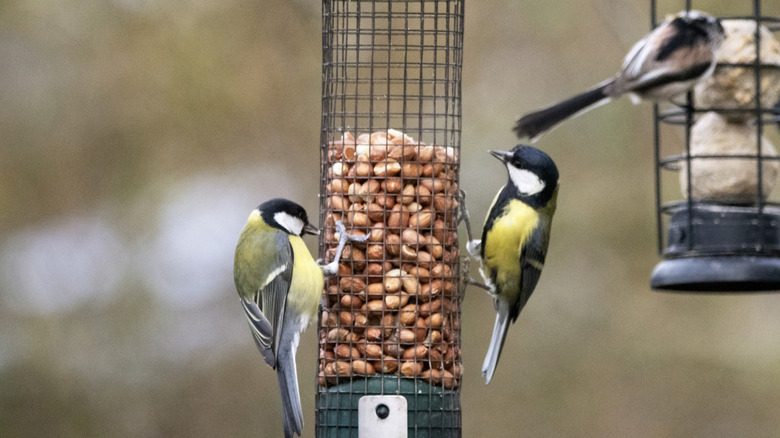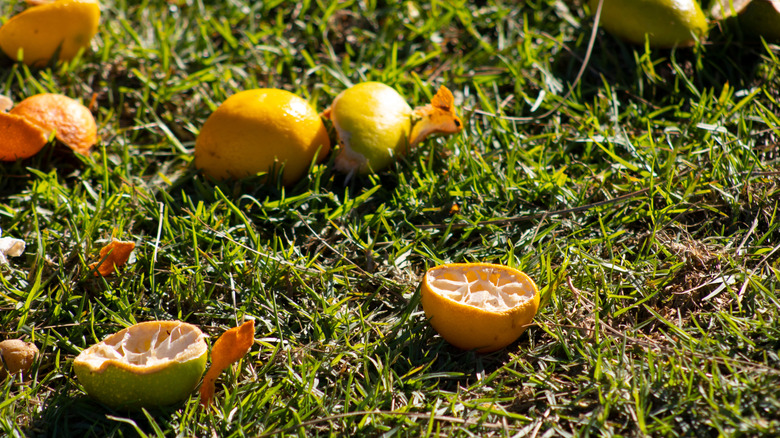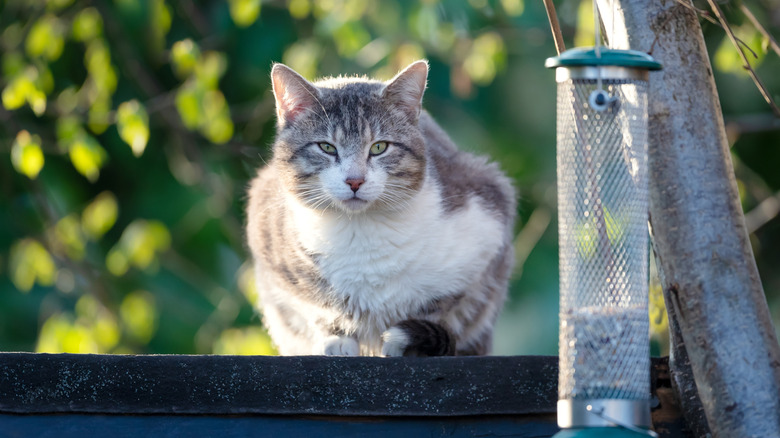Why You May Want To Throw A Few Citrus Peels Around Your Bird Feeder
If you're a bird enthusiast, you probably find joy in having a bird feeder in your yard. However, if you (or your neighbors) let cats roam free outdoors, your bird feeder can easily turn into a gruesome hunting ground. Cats are wired to stalk and capture birds, and this behavior poses a grave threat to the avian guests (not to mention that it disrupts the tranquility you seek in your backyard). Unfortunately, there's no guaranteed way to keep the birds out of danger as long as cats are allowed in the yard. That said, there are a few things you can do to discourage felines from coming close to your bird feeder; one of these involves strategically placed citrus peels acting as a cat repellent. You can try the same trick to keep cats out of your garden beds.
The reason citrus peels can be used as a feline repellent is because cats generally find their scent to be overwhelming for their sniffers. When you scatter citrus peels around the bird feeder, you're establishing a fragrant barrier that reduces the likelihood of your cat ending up in the vicinity. Use this method alongside other deterrents, including proper landscaping and situating the feeder in an inaccessible location.
How to repel cats from bird feeders using citrus peels
If you want to test out this hack, collect the peels from oranges, limes, or any other citrus fruits you consume, and air-dry them for a couple of days. Drying the peels concentrates the citrusy aroma that cats dislike. Once dried, place the peels around the base of the feeder to create a natural barrier. If you have a large quantity of peels on hand, scatter them around the feeder to dissuade cats from taking strolls in the vicinity. Replace the peels with new ones every few days to maintain their potency.
Note that all parts of citrus fruits, including peels, are toxic to cats if ingested. Though it's unlikely to happen due to cats' aversion to citrus smells, watch your pets when they're outdoors and make sure they don't eat the peels. If you find that using citrus peels aren't a strong enough repellent, consider trying a few other methods that keep cats away from your birds.
Other ways to keep cats away from bird feeders
The only surefire way to safeguard birds from domesticated cats is to keep the cats indoors. That said, if you're determined to let your pet roam free outdoors or have neighborhood cats whose access you can't restrict, citrus peels aren't the only deterrent to experiment with. In fact, you should try a holistic strategy with several barriers working in concert with the design of the landscape.
Start by making the bird feeder as inaccessible as possible. Cats may climb up a pole if they're really set on doing so, which is why hanging the feeder on a wire between two trees is ideal. To ensure that your pet can't jump onto it from the trunk or branches, the feeder should be at least 8 feet above the ground and 4 feet away from either tree. If the trees are closer than 8 feet apart, install a wide strip of metal flashing around their' trunks. This way, the cats will have a harder time climbing up and jumping to the feeder.
You may be tempted to grow vegetation to provide cover for the birds — after all, that's how they hide from predators in the wild. But any shrubs, grasses, or flowers you plant will also serve as cover for the cats while they're out on a hunt, so this strategy may be doing more harm than good. In fact, it's best not to grow dense vegetation within 15 feet or so of the bird feeder. On the other hand, installing motion detection sprinklers — which spray approaching cats with a gentle but unexpected stream of water — could be a more effective, albeit not 100% foolproof, way to discourage your pet from staking out the bird feeder.


